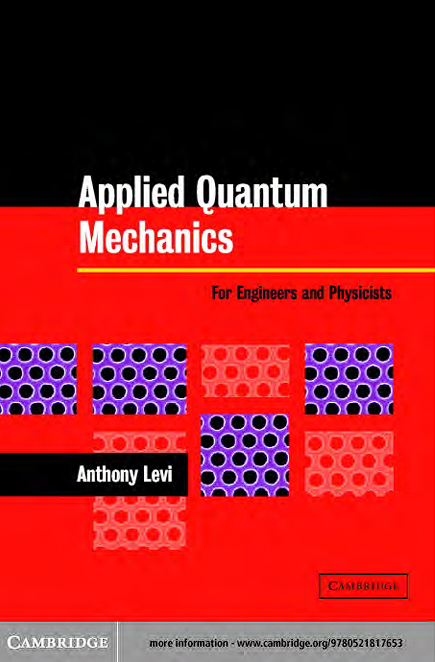
APPLIED QUANTUM MECHANICS
Author: WALTERA. HARRISON Category: Mekanika Kuantum Publisher: World Scientific Publishing ISBN: 978-0-511-07837-8 The theory of quantum mechanics forms the basis for our present understanding of
physical phenomena on an atomic and sometimes macroscopic scale. Today, quantum
mechanics can be applied to most fields of science. Within engineering, important sub
jects of practical significance include semiconductortransistors, lasers, quantumoptics,
and molecular devices. As technology advances, an increasing number of new elec
tronic and opto-electronic devices will operate in ways which can only be understood
using quantum mechanics. Over the next 30 years, fundamentally quantum devices
such as single-electron memory cells and photonic signal processing systems may well
become commonplace. Applications will emerge in any discipline that has a need to
understand, control, and modify entities on an atomic scale. As nano- and atomic-scale
structures become easier to manufacture, increasing numbers of individuals will need
to understand quantum mechanics in order to be able to exploit these new fabrication
capabilities. Hence, one intent of this book is to provide the reader with a level of
understanding and insight that will enable him or her to make contributions to such
future applications, whatever they may be.
Thebookisintendedforuseinaone-semesterintroductorycourseinappliedquantum
mechanics for engineers, material scientists, and others interested in understanding the
critical role of quantum mechanics in determining the behavior of practical devices.
To help maintain interest in this subject, I felt it was important to encourage the reader
to solve problems and to explore the possibilities of the Schrödinger equation. To
ease the way, solutions to example exercises are provided in the text, and the enclosed
CD-ROMcontainscomputerprogramswrittenintheMATLABlanguagethatillustrate
these solutions. Thecomputerprogramsmaybeusefullyexploitedtoexploretheeffects
of changing parameters such as temperature, particle mass, and potential within a given
problem. In addition, they may beusedasastarting point in the development of designs
for quantum mechanical devices.
The structure and content of this book are influenced by experience teaching the
subject. Surprisingly, existing texts do not seem to address the interests or build on the
computingskills of today’s students. This book is designed to better match such student
needs.
Some material in the book is of a review nature, and some material is merely an
introduction tosubjectsthatwillundoubtedlybeexploredindepthbythoseinterestedin
pursuing moreadvancedtopics.Themajorityofthetext, however,is anessentially self
contained study of quantum mechanics for electronic and opto-electronic applications.
There are many important connections between quantum mechanics and classical
mechanics and electromagnetism. For this and other reasons, Chapter 1 is devoted to a
review ofclassical concepts. This establishes a point of view with which the predictions
of quantum mechanics can be compared. In a classroom situation it is also a conve
nient way in which to establish a uniform minimum knowledge base. In Chapter 2 the
Schrödinger wave equation is introduced and used to motivate qualitative descriptions
of atoms, semiconductor crystals, and a heterostructure diode. Chapter 3 develops the
moresystematic use oftheone-dimensional Schrödinger equation to describe a particle
in simple potentials. It is in this chapter that the quantum mechanical phenomenon of
tunneling is introduced. Chapter 4 is devoted to developing and using the propagation
matrix methodtocalculateelectronscattering fromaone-dimensionalpotentialofarbi
trary shape. Applications include resonant electron tunneling and the Kronig–Penney
model of a periodic crystal potential. The generality of the method is emphasized
by applying it to light scattering from a dielectric discontinuity. Chapter 5 introduces
somerelated mathematics, the generalized uncertainty relation, and the concept of den
sity of states. Following this, the quantization of conductance is introduced. The har
monicoscillator is discussed in Chapter 6 using the creation and annihilation operators.
Chapter 7 deals with fermion and bosondistribution functions. This chapter shows how
to numerically calculate the chemical potential for a multi-electron system. Chapter 8
introduces and then applies time-dependent perturbation theory to ionized impurity
scattering in a semiconductor and spontaneous light emission from an atom. The semi
conductor laser diode is described in Chapter 9. Finally, Chapter 10 discusses the (still
useful) time-independent perturbation theory.
Throughout this book, I have made applications to systems of practical importance
the main focus and motivation for the reader. Applications have been chosen because
of their dominant roles in today’s technologies. Understanding is, after all, only useful
if it can be applied
Back